 W
WThe action of August 1702 was a naval battle that took place from 19–25 August 1702 O.S. between an English squadron under Vice-Admiral John Benbow and a French under Admiral Jean du Casse, off Cape Santa Marta on the coast of present-day Colombia, South America, during the War of the Spanish Succession. Benbow vigorously attacked the French squadron, but the refusal of most of his captains to support the action allowed du Casse to escape. Benbow lost a leg during the engagement and died of illness about two months later. Two of the captains were convicted of cowardice and shot.
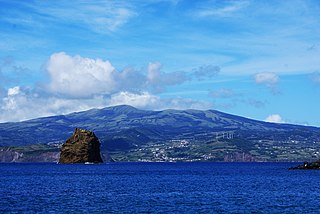 W
WThe action of Faial or the Battle of Faial Island was a naval engagement that took place on 22–23 June 1594 during the Anglo-Spanish War in which the large and rich 2,000 ton Portuguese carrack Cinco Chagas was destroyed by an English fleet after a long and bitter battle off Faial Island in the Azores. The carrack, which was reputedly one of the richest ever to set sail from the Indies, was lost in an explosion which denied the English, as well as the Portuguese and Spanish, the riches.
 W
WThe action off Bermuda, also known as Grenville's action off the Bermuda's, was a minor naval engagement that took place off the island of Bermuda over three days in late August 1585 during the Anglo–Spanish War between an English galleass, Tiger, and a larger Spanish galleon, Santa Maria de San Vicente. Tiger was victorious when the Spanish ship surrendered after a severe bombardment.
 W
WThe Azores Voyage of 1589, also known as Cumberland's Third Voyage, was a series of conflicts in the Azores islands between August and September 1589 by an English military joint stock expedition led by George Clifford, 3rd Earl of Cumberland, during the Anglo–Spanish War. All the islands were attacked either for provisions or the attainment of Spanish and Portuguese prizes. A number of Portuguese and Spanish ships were captured and also included a battle at Faial which resulted in the capture of the fort and the main town, which was subsequently sacked and burned. The English were able to return home unmolested with a total of thirteen prizes – the expedition was a success and with a good profit for the investors although many lives were lost to disease and storms.
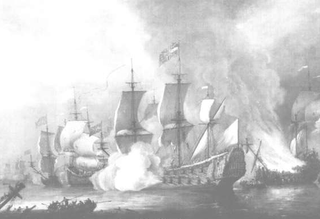 W
WThe Battle of Bantry Bay was a naval engagement fought on 11 May 1689, a week before the declaration of the Nine Years' War. The English fleet was commanded by Admiral Arthur Herbert, created Earl of Torrington after the Battle; the French fleet by François Louis de Rousselet, Marquis de Châteaurenault. Apart from the inshore operations at La Rochelle in 1627–28, the Battle of Bantry Bay was the first time English and French navies had met in fleet action since 1545.
 W
WThe Battles of Barfleur and La Hougue took place during the Nine Years' War, between 19 May Old Style and 4 June Old Style 1692. The first was fought near Barfleur on 19 May Old Style, with later actions occurring between 20 May Old Style and 4 June Old Style at Cherbourg and Saint-Vaast-la-Hougue in Normandy, France.
 W
WThe Battle of São Vicente was a minor naval engagement that took place off São Vicente, Portuguese Brazil on 3 February 1583 during the Anglo–Spanish War between three English ships, and three Spanish galleons. The English under Edward Fenton on an expedition having failed to enter the Pacific, then attempted to trade off Portuguese Brazil but were intercepted by a detached Spanish squadron under Commodore Andrés de Equino. After a moonlit battle briefly interrupted by a rainstorm the Spanish were defeated with one galleon sunk and another heavily damaged along with heavy losses. Fenton then attempted to resume trading but without success and thus returned to England.
 W
WThe Battle of Bayona Islands, also known as the Battle of Bayona Bay, was a naval engagement that took place in early 1590, off Bayona Islands, near Bayona and Vigo, Spain, between a small Spanish naval force commanded by Captain Don Pedro de Zubiaur, and an Anglo-Dutch flotilla of 14 ships, during the Eighty Years' War, and in the context of the Anglo-Spanish War (1585–1604) and the French Wars of Religion. After several hours of hard combat, the Spanish naval force composed of three flyboats achieved a great success, and the Anglo-Dutch fleet was totally defeated. The flagship of the Dutch was boarded and captured, including another six ships more. Finally, the rest of the Dutch fleet was forced to surrender. Shortly after, Pedro de Zubiaur arriving at Ferrol, along with the captured ships, with great surprise for the Spanish authorities of the port.
 W
WThe Battle of Beachy Head was a naval battle fought on 10 July 1690 during the Nine Years' War. The battle was the greatest French tactical naval victory over their English and Dutch opponents during the war. The Dutch lost six ships of the line and three fireships; their English allies also lost one ship of the line, whereas the French did not lose a vessel. Control of the English Channel temporarily fell into French hands but Vice-Admiral Tourville failed to pursue the Allied fleet with sufficient vigour, allowing it to escape to the River Thames.
 W
WThe Battle of Berlengas Islands was a naval battle which took place off the Portuguese coast on 15 July 1591, during the war between Elizabeth I of England and Philip II of Spain. It was fought between an English privateer squadron under George Clifford, 3rd Earl of Cumberland, who had set out his fortunes by large-scale privateering, and a squadron of 5 Spanish galleys commanded by Francisco Coloma tasked with patrolling the Portuguese coast against privateers. While anchored off the Berlengas, the English ships were surprised by the Spanish galleys, which succeeded in taking one English ship and rescuing two prizes.
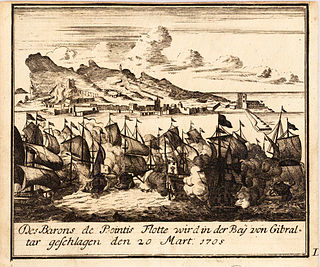 W
WThe Battle of Cabrita Point, sometimes referred to as the Battle of Marbella, was a naval battle that took place while a combined Spanish-French force besieged Gibraltar on 10 March 1705 during the War of Spanish Succession.
 W
WOn 18–19 December 1669, a battle took place in the waters near Cádiz between the English fourth-rate frigate Mary Rose under the command of Rear-Admiral John Kempthorne, escorting several merchantmen, and a group of seven pirate ships operating out of Algiers. The incident was recorded and drawn by the engraver Wenceslaus Hollar, with an engraving appearing in John Ogilby's Africa.
 W
WThe Battle of Camaret was an amphibious landing at Camaret Bay on 18 June 1694 by the English and Dutch in an attempt to seize the French port of Brest and destroy part of the French fleet stationed there, as part of the Nine Years' War. It was successfully opposed by Sébastien Le Prestre de Vauban.
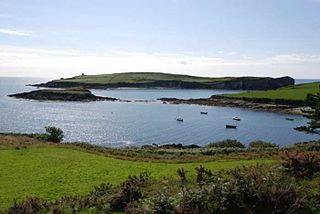 W
WThe Battle of Castlehaven was a naval battle that took place on 6 December 1601 in the bay off Castlehaven on the south coast of Ireland during the Nine Years' War between a Spanish naval convoy of six ships and an English fleet, commanded by Admiral Richard Leveson and consisting of four warships. The Spanish convoy was protected by fortified positions on shore, a castle, and 600 Spanish and Irish footmen. Five out of six Spanish ships, commanded by General Pedro de Zubiaur were either sunk, captured, or run aground in the battle, while the English fleet lost no ships.
 W
WLefebvre's Charles Town expedition was a combined French and Spanish attempt under Captain Jacques Lefebvre to capture the capital of the English Province of Carolina, Charles Town, during Queen Anne's War.
 W
WThe Battle of Damme was fought on 30 and 31 May 1213 during the 1213–1214 Anglo-French War. An English fleet led by William Longespée, Earl of Salisbury accidentally encountered a large French fleet under the command of Savari de Mauléon in the vicinity of the port of Damme, in Flanders. The French crews were mostly ashore, pillaging the countryside, and the English captured 300 French ships at anchor, and looted and fired a further hundred beached ships. The main French army, commanded by King Philip II of France, was nearby besieging Ghent and it promptly marched on Damme. It arrived in time to relieve the town's French garrison and drive off the English landing parties. Philip had the remainder of the French fleet burned to avoid capture. The success of the English raid yielded immense booty and ended the immediate threat of a French invasion of England. It is often considered the first great naval victory in English history.
 W
WThe Battle of the Gulf of Almería, also known as the Battle of Almería Bay or the Battle of Cape of Palos, was a naval Spanish victory that took place in late August, 1591, off Almería, near the Cape Palos, during the Eighty Years' War and the Anglo–Spanish War (1585–1604). The battle occurred when the Spanish fleet of the Adelantado of Castile, Don Martín de Padilla y Manrique, Count of Santa Gadea, sighted an Anglo-Dutch fleet in the waters of Almería, on the southern coast of Spain. The Spanish fleet, led by Martín de Padilla, attacked with such fury the Anglo-Dutch fleet who managed to undo their training, achieved a great success. About 20 Dutch ships and 3 English ships were captured by the Spaniards, and some ships of the rest of the Anglo-Dutch fleet were seriously damaged. On the other hand, the Spanish losses were minimal.
 W
WThe Battle of Helgeå, or Battle of the Holy River, was a naval engagement which took place in 1026 between joint Danish and English forces and a combined Norwegian and Swedish force, at the estuary of a river called Helge in Sweden.
 W
WThe Battle of Hudson's Bay, also known as the Battle of York Factory, was a naval battle fought during the War of the Grand Alliance. The battle took place on 5 September 1697, when a French warship commanded by Captain Pierre Le Moyne d'Iberville defeated an English squadron commanded by Captain John Fletcher. As a result of this battle, the French took York Factory, a trading post of the Hudson's Bay Company.
 W
WThe Battle of La Rochelle was a naval battle fought on 22 and 23 June 1372 between a Castilian fleet commanded by the Castilian Almirant Ambrosio Boccanegra and an English fleet commanded by John Hastings, 2nd Earl of Pembroke. The Castilian fleet had been sent to attack the English at La Rochelle, which was being besieged by the French. Besides Boccanegra, other Castilian commanders were Cabeza de Vaca, Fernando de Peón and Ruy Díaz de Rojas.
 W
WThe Battle of Lagos was a sea battle during the Nine Years' War on 27 June 1693, when a French fleet under Anne Hilarion de Tourville defeated an Anglo-Dutch fleet under George Rooke near Lagos Bay in Portugal. Rooke's squadron was protecting the Smyrna convoy, and it is by this name that the action is sometimes known.
 W
WThe naval Battle of Lagos took place between a British fleet commanded by Sir Edward Boscawen and a French fleet under Jean-François de La Clue-Sabran over two days in 1759 during the Seven Years' War. They fought south west of the Gulf of Cádiz on 18 August and to the east of the small Portuguese port of Lagos, after which the battle is named, on 19 August.
 W
WThe Battle off Lizard Point was a naval action which took place on 18 February 1637 off the coast of Cornwall, England, during the Eighty Years' War. The Spanish admiral Miguel de Horna, commander of the Armada of Flanders, intercepted an important Anglo-Dutch merchant convoy of 44 vessels escorted by six warships, destroying or capturing 20 of them, and returned safely to his base in Dunkirk.
 W
WThe Battle of Málaga was the largest naval battle in the War of the Spanish Succession. It took place on 24 August 1704 N.S., south of Vélez-Málaga, Spain.
 W
WThe Battle of Margate, also known as the Battle of Cadzand, was a naval battle that took place 24–25 March 1387 during the Caroline War phase of the Hundred Years' War between an English fleet and a Franco-Castilian-Flemish wine fleet.
 W
WThe Battle of Martinique also known as Harman's Martinican Bonfire was a major naval battle fought in the Caribbean island of Martinique at St Pierre, from 30 June to 7 July 1667 that came towards the end of the Second Anglo-Dutch War. A French merchantile fleet anchored in the bay led by Joseph-Antoine Le Fèvre de la Barre were attacked by an English fleet led by Admiral Sir John Harman. The English were victorious, virtually wiping out the French merchant fleet in the Caribbean, which was unaccompanied by any naval vessels, and enabled them to secure their domination and position in the West Indies despite being at the war's end.
 W
WThe Raid on Nassau, on the Bahamian island of New Providence, was a privately raised Franco-Spanish expedition against the English taking place in October 1703, during the War of the Spanish Succession; it was a Franco-Spanish victory, leading to Nassau's brief occupation, then its destruction. The joint Bourbon invasion was led by Blas Moreno Mondragón and Clause Le Chesnaye, with the attack focusing on Nassau, the capital of the English Bahamas, an important base of privateering for English corsairs in the Cuban and Saint Domingue's Caribbean seas. The town of Nassau was quickly taken and sacked, plundered and burnt down. The fort of Nassau was dismantled, and the English governor, with all the English soldiers were carried off prisoners. A year later, Sir Edward Birch, the new English governor, upon landing in Nassau, was so distraught at the ruin he found, that he returned to England after only a few months, without "unfurling his company-issued commission".
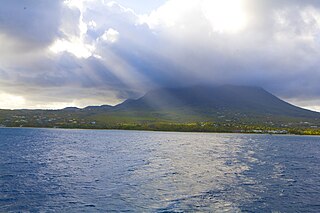 W
WThe Battle of Nevis on 20 May 1667 was a confused naval clash in the Caribbean off the Island of Nevis during the closing stages of the Second Anglo-Dutch War between an English squadron and an Allied Franco-Dutch fleet intent on invading the island. The battle ended up being an English victory in that prevented a Franco-Dutch invasion of Nevis.
 W
WThe Newfoundland expedition was a naval raiding expedition led by English Captain John Leake between August and October 1702 that targeted French colonial settlements on the North Atlantic island of Newfoundland and its satellite Saint Pierre. The expedition occurred in the early days of Queen Anne's War, as the North American theater of the War of the Spanish Succession is sometimes known.
 W
WThe Newfoundland Expedition also known as Bernard Drake's Newfoundland Expedition was an English naval expedition that took place during the beginning of the declared Anglo-Spanish War in the North Atlantic during summer and autumn of 1585. The area of conflict was situated mainly in an area known as the Grand Banks off present day Newfoundland. The aim of the expedition was to capture the Spanish and Portuguese fishing fleets. The expedition was a huge military and financial success and virtually removed the Spanish and Portuguese from these waters. In addition the raid had large consequences in terms of English colonial expansion and settlement.
 W
WThe Battle of Orford Ness was a naval battle fought between a southbound Swedish convoy escorted by the Swedish warship Öland and an English squadron of eight ships of the line and a frigate off the coast of Orford Ness on 27 July 1704. The English squadron started to follow the Swedish convoy upon sighting it and when they caught up with the Swedes, demanded a salute due to Psilander being in English waters. The Swedish commander Gustaf von Psilander, under strict orders from his king not to, refused. A four-hour battle ensued, with the heavily damaged Öland being captured alongside the convoyed merchant ships. The Swedish Board of Admiralty and Board of Trade refused to demand for his release or support Psilander while he was in captivity, but Charles XII was of a different opinion and successfully demanded the release of the warship and crew. Psilander, his crew, and the convoyed ships were later released and returned to Sweden. However, Öland later sank north of Denmark while homebound.
 W
WThe Battle of Pantelleria (1586) also known as the Fight at Pantalarea was a naval engagement that took place during the Anglo–Spanish War off the island of Pantelleria on 13 July 1586. The encounter was between an English armed merchant fleet of five ships of the Levant Company in convoy under Edward Wilkinson and a fleet of eleven Spanish and Maltese galleys under Don Pedro de Leyva. The English managed to repel all the attacks and returned home unmolested. Although minor the battle had significant consequences in testing English firepower of which was to be used against the Spanish armada two years later when England was under threat of invasion.
 W
WThe Battle of Ronas Voe was a naval engagement between the English Royal Navy and the Dutch East India ship Wapen van Rotterdam on 14 March 1674 in Ronas Voe, Shetland as part of the Third Anglo-Dutch War. Having occurred 23 days after the signing of the Treaty of Westminster, it is likely to have been the final battle of the Third Anglo-Dutch War.
 W
WThe Naval battle off St. John took place on 22 September 1691 between France and England toward the beginning of King William's War in the Bay of Fundy off present-day Saint John, New Brunswick. The English ship sailed with the new British Governor of Acadia Edward Tyng while the French ship sailed with the French Governor of Acadia Joseph Robineau de Villebon.
 W
WThe Naval battle off St. John took place on July 14, 1696, between France and England toward the end of King William's War in the Bay of Fundy off present-day Saint John, New Brunswick. The English ships were sent from Boston to interrupt the supplies being taken by French officer Pierre Le Moyne d'Iberville from Quebec to the capital of Acadia, Fort Nashwaak on the Saint John River. The French ships of war Envieux and Profond captured the English frigate Newport, while the English frigate Sorlings and a provincial tender escaped.
 W
WThe Battle of San Juan de Ulúa was fought between English privateers and Spanish forces at San Juan de Ulúa. The English flotilla of six armed merchant ships under John Hawkins had been trading along the Spanish Main with the cooperation of local Spanish officials. However the central Spanish authorities considered this to be illegal smuggling that violated the Treaty of Tordesillas.
 W
WThe Battle of Santa Cruz de Tenerife was a military operation in the Anglo-Spanish War (1654–60) which took place on 20 April 1657. An English fleet under Admiral Robert Blake penetrated the heavily defended harbour at Santa Cruz de Tenerife in the Spanish Canary Islands and attacked their treasure fleet. The treasure had already been landed and was safe but the English engaged the harbour forts and the Spanish ships, many of which were scuttled and the remainder burnt. Blake having achieved his aim then withdrew without the loss of a single ship.
 W
WThe Battles of Schooneveld were two naval battles of the Franco-Dutch War, fought off the coast of the Netherlands on 7 June and 14 June 1673 between an allied Anglo-French fleet commanded by Prince Rupert of the Rhine on his flagship the Royal Charles, and the fleet of the United Provinces, commanded by Michiel de Ruyter.
 W
WThe Battle of Sluys, also called the Battle of l'Écluse, was a naval battle fought on 24 June 1340 between England and France. It took place in the roadstead of the port of Sluys, on a since silted-up inlet between Zeeland and West Flanders. The English fleet of 120–150 ships was led by Edward III of England and the 230-strong French fleet by the Breton knight Hugues Quiéret, Admiral of France, and Nicolas Béhuchet, Constable of France. The battle was one of the opening engagements of the Hundred Years' War.
 W
WThe naval Battle of the Solent took place on 18 and 19 July 1545 during the Italian Wars between the fleets of Francis I of France and Henry VIII of England, in the Solent, between Hampshire and the Isle of Wight. The engagement was inconclusive, and is most notable for the sinking of the English carrack, Mary Rose.
 W
WThe Battle of the Strait of Gibraltar was a naval action off Gibraltar on 24th of April, 1591. A fleet of three English merchant vessels escorted by a larger armed merchant vessel Centurion was attacked by five Spanish galleys. Ultimately, the Spanish were repelled, but not before the English vessel Dolphin was sunk by one of the galleys.
 W
WThe Battle of the Barbary Coast was a minor naval engagement that took place off in the Barbary Coast not far from the Gibraltar Strait, on July 26, 1592 during the Anglo-Spanish War. The hard fought action by an English merchant galleon in the Amity of London captained by Thomas White resulted in the capture of two Spanish ships which included a galleon despite them being outnumbered four to one. The prizes were heavily laden with quicksilver and a large amount of very important Papal bulls bound for the West Indies.
 W
WThe Battle of the Bay of Biscay of 1592 was a naval engagement that took place in waters of the Bay of Biscay, in November 1592, between a Spanish naval force of 5 flyboats commanded by Captain Don Pedro de Zubiaur and an English convoy of 40 ships, supported by a 6-warship squadron, during the Anglo-Spanish War (1585–1604) and the French Wars of Religion. The Spanish force led by Captain Zubiaur, despite being outnumbered, engaged the English ships, achieving a resounding success. The English flagship was boarded and burned, causing great confusion among the English convoy. Shortly after, another English force composed of six warships, arrived at the battle, and tried to defend the convoy. After long and intense fighting, the Spaniards were victorious in battle, and three more English ships were captured, besides several ships seriously damaged.
 W
WThe Battle of Vigo Bay, also known as the Battle of Rande, was a naval engagement fought on 23 October 1702 during the opening years of the War of the Spanish Succession. The engagement followed an Anglo-Dutch attempt to capture the Spanish port of Cádiz in September in an effort to secure a naval base in the Iberian Peninsula. From this station the Allies had hoped to conduct operations in the western Mediterranean Sea, particularly against the French at Toulon. The amphibious assault, however, had proved a disaster, but as Admiral George Rooke retreated home in early October, he received news that the Spanish treasure fleet from America, laden with silver and merchandise, had entered Vigo Bay in northern Spain. Philips van Almonde convinced Rooke to attack the treasure ships, despite the lateness of the year and the fact that the vessels were protected by French ships-of-the-line.
 W
WThe Battle of Winchelsea or the Battle of Les Espagnols sur Mer was a naval battle that took place on 29 August 1350 and was a victory for an English fleet of 50 ships, commanded by King Edward III, over a Castilian fleet of 47 larger vessels, commanded by Charles de La Cerda. Between 14 and 26 Castilian ships were captured, and several were sunk. Only two English vessels were sunk, but there was a significant loss of life. The battle was part of the Hundred Years' War between England and France.